Buying & Storing Grains
Buying Wheat Berries: Should I Buy Organic?
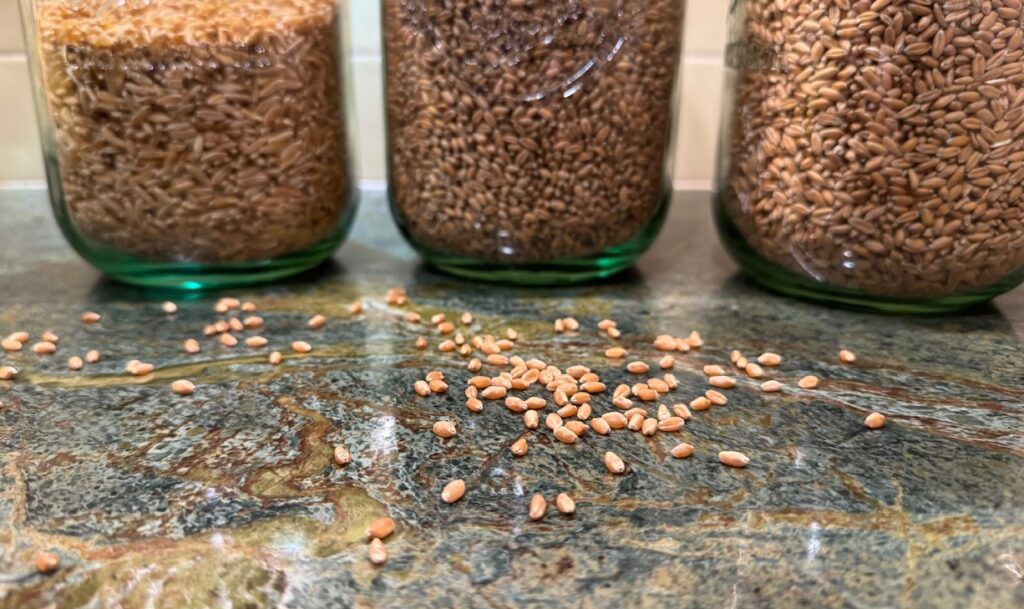
I personally prefer organic or regeneratively grown wheat because I figure, if I am going to mill my own wheat for the health benefits, it’s a good plan to also avoid as many chemicals as possible.
A label on wheat that says “non-GMO” means nothing because right now, all wheat in the US is not genetically modified. I buy organic wheat to avoid glyphosates (Round-Up) and other nasty chemicals. In the US, glyphosates are sometimes sprayed on non-organic crops to desiccate them prior to harvesting. No thanks!
Regeneratively grown farms also adhere to fantastic farming practices and based on what I know, I also trust grains from farmers who grow regeneratively.
My Favorite Grain Companies
I buy in bulk for the best prices and I don’t like paying a ton for shipping unless the price of the grain is low enough to even it out. So this is not a comprehensive list! It’s a list of places I personally feel good about! I will continue adding to this list as I find more places to order from!
- Central Milling: I buy a lot from CM but you have to be prepared to deal with 50lb bags! The price is right, even though the shipping isn’t cheap!
- Blue Bird Grains: local here in Washington state. They recently started a flat fee shipping of $9.99 and I hope it continues because that’s stellar and it helps make up for the higher grain prices. If you are in the Seattle area and belong to PCC you can order a few of their grains directly through them as well. I believe you can also do this at Marlene’s and 21 Acres Farms. But with ten dollar shipping, it’s worth it to just order directly!
- Janie’s Mill: I have ordered so much from JM. They have a coupon at the top of their website for free shipping on a $100+ order. They have a wide variety of grain types too! I enjoyed testing out some of them! Read the descriptions on them to see what they are all about. So much fun.
- Guardian Grains: Regeneratively grown, family run, free shipping with a minimum order. I love the Rouge de Bordeaux and their Egyptian Barley (so far)! These are special grains that I am willing to pay a bit more for. I also like supporting a small family farm.
- Bench View Farms: I like this company as it’s family run. Their prices look higher than other places but it’s because they incorporate the cost of shipping! So it’s “free shipping” in a way. I get a laugh when the grains arrive, crammed into USPS Flat Rate boxes that are bursting at the seams! Ha! I’m sure the post office isn’t happy about that but it works! BVF has organic Khorasan wheat which is the SAME as the branded khorasan wheat called Kamut. I have had both, they are equal.
- Azure Standard: I have to add Azure here even though I rarely buy grains from them anymore (also, this is my personal link that gives me a little bonus when you sign up with it). Between myself, my mom, and my BFF, we have ordered a few hundred pounds of organic grains from Azure and we have had nothing but good experiences. BUT there are a lot of people out there that have issues and I decided that I would start ordering from other places to minimize the risk of getting a “bad bag”. They have great prices though, so it’s a perfect place to get started with a grain set-up! I DO ORDER LOTS OF OTHER STUFF! I order everything from cheese to buckets from Azure! Coffee beans, honey, coconut, canning jars, food grade buckets with gamma lids, mylar bags, and so much more! I love my Azure orders! But you have to find a “drop point” near you and arrange to pick up from it. Then Azure delivers everyone’s orders to that drop point and you get your stuff that way. My drop point is a house with a carport and we have a couple hours to pick up. Other drop points are set up where you have to meet the truck in a parking lot with all of the other people who use your drop point and get your stuff right at the time of delivery. The volunteers who run drop points all have their various ways of running them.
- Grand Teton: I am adding this to my list because I have heard fabulous things but I have yet to try them!
Storing Grains
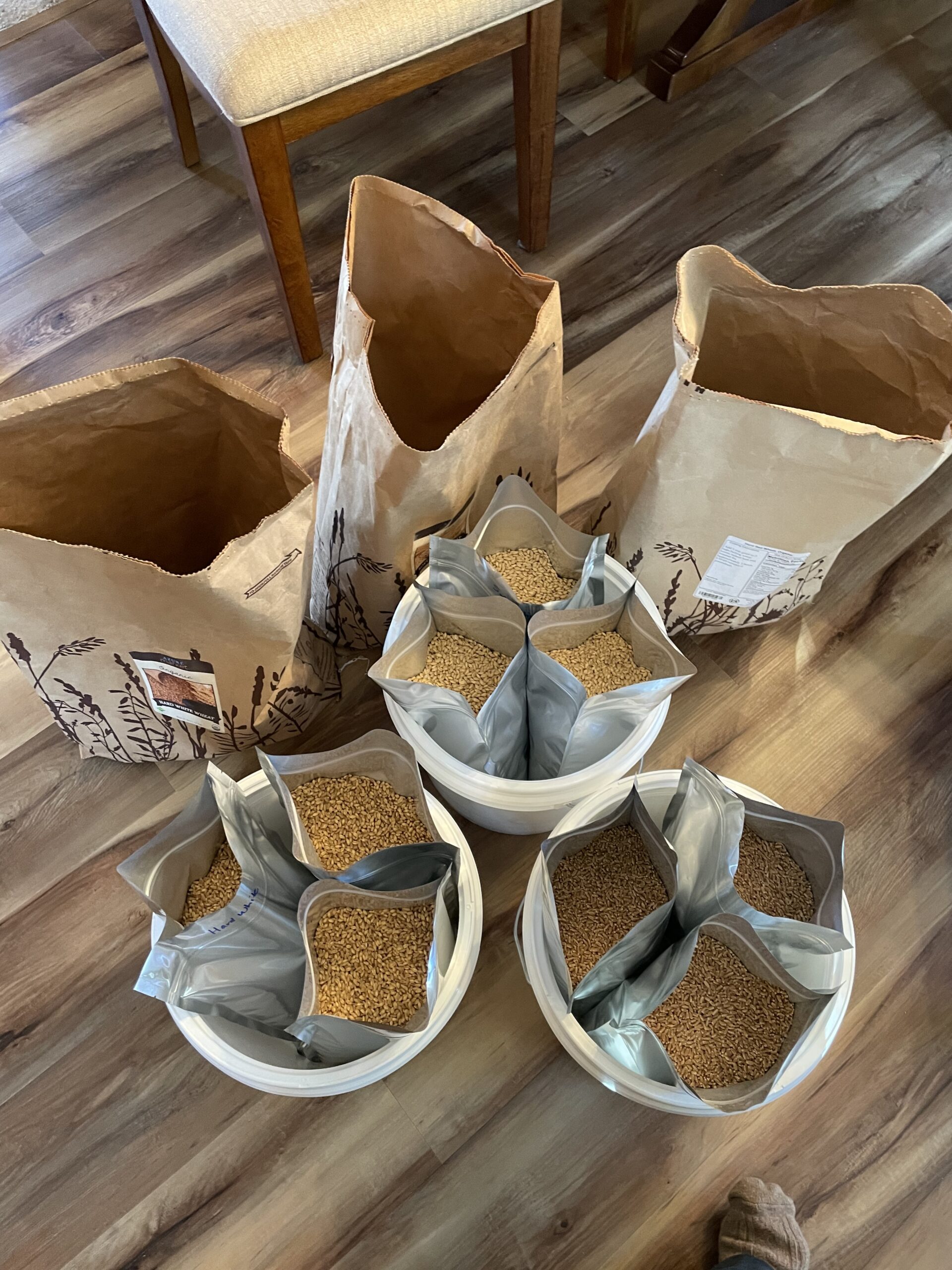

Can you be "too" safe? I don't think so!
I have to start by saying that there are a lot of opinions out there about storing grains and this is what I feel comfortable with after doing my research. Please feel free to do more research and do what works best for you!
I use 1 gallon Mylar bags with oxygen absorbers, heat sealed, which makes these grains ready for long term, and I mean LONG term storage AND it kills any bug-potential. I do keep these bags in buckets with gamma lids as well but any hard plastic containers will work! With the grains being in the mylar, you no longer need to worry about the bucket/bin being “food safe”, you just need added protection from outside critters. Keep reading if you want the details about how and why I prep my grains this way!
Oxygen Absorbers
Oxygen absorbers suck the oxygen out of the bag which leaves the nitrogen behind. The nitrogen-rich environment doesn’t let anything survive. Grains can arrive with bugs or bug eggs and this is just part of the industry. Weevils, usually. Both the adults and the eggs are killed when stored with oxygen absorbers. Win! You can see in the photo here that all the air has been “sucked out” and the bags are compressed. This can take a day or two and that’s when you know you got a good seal. If not, open them, put a new O2 pack in, and heat seal again.
Be careful! You MUST get the correct size of oxygen absorber packs for the container size you are using, or moisture can form (a botulism risk)! You can see the moisture in this jar that I was trying to store my O2 packs in! According to Azure, the 300cc sized oxygen absorber packs are the correct size for one gallon mylar bags. I have seen other places say that 400cc is also ok. If you use larger bags, you use more cc. Be sure to research this!
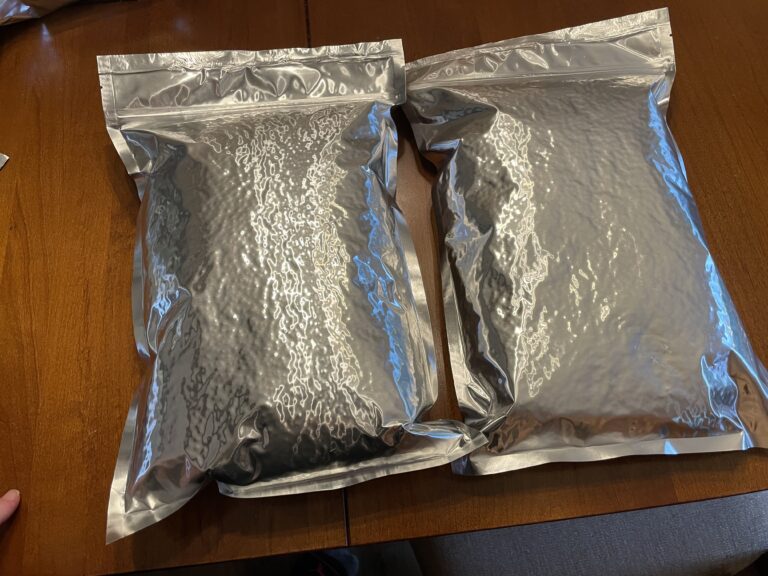

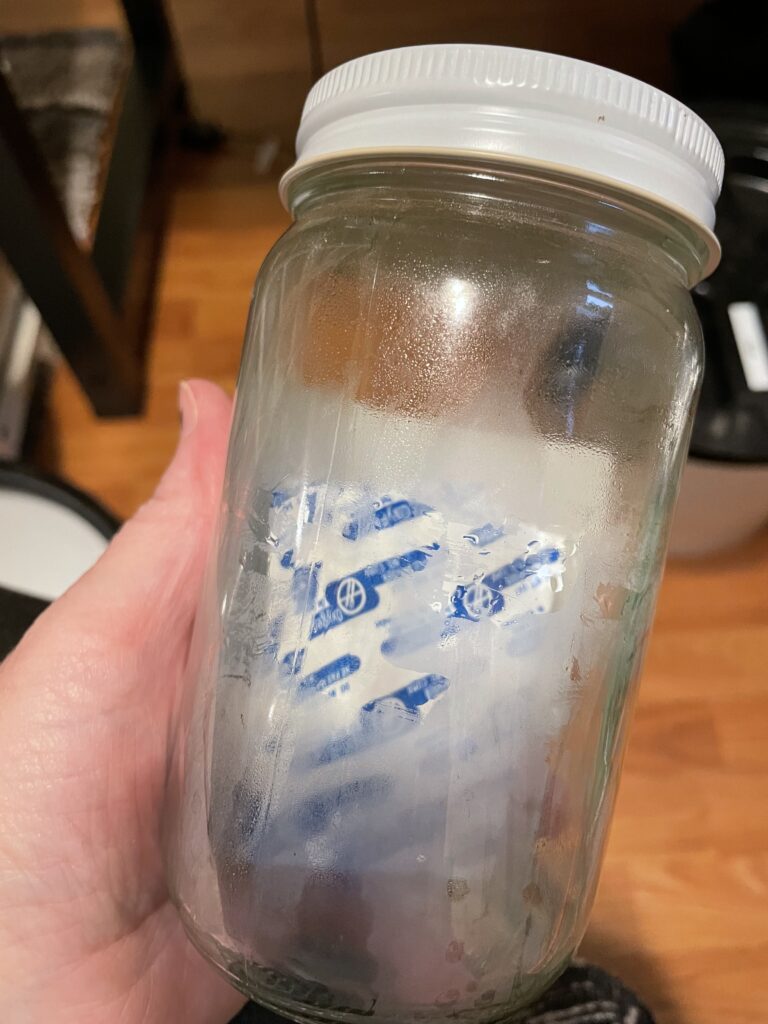

Kitchen VS Garage Storage
I keep several grains in half gallon jars in my kitchen and I keep a couple types in larger containers on my counter. The rest is in my garage as it does not get too hot or too cold (cold is not a problem though). I use metal lids with silicone lining on my jars for an airtight seal. I keep my buckets sorted by grain-type, with labels of course, and I use gamma lids which makes access easier as they screw on and off. The reason I don’t pour wheat directly into the buckets is because you are not supposed to use oxygen absorbers with the gamma lids as they can’t handle the pressure that forms. The oxygen absorbers within a mylar bag keeps that suction within the bag and doesn’t affect the bucket.
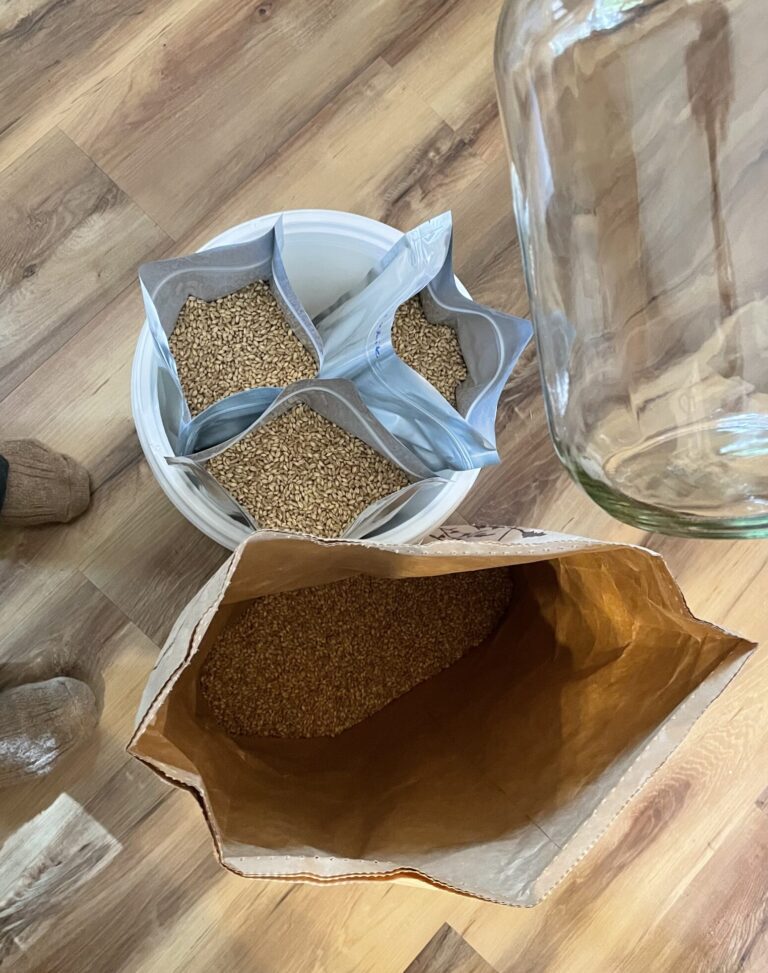

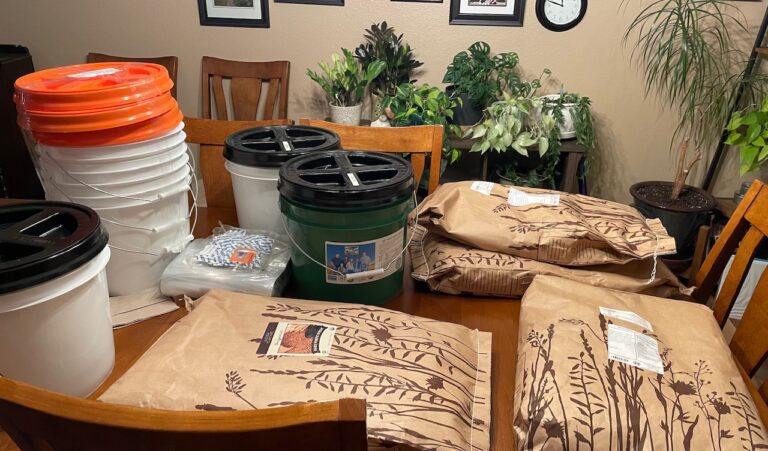

Bucket and Bag Sizes!
I have a mixture of food-safe 3.5 gallon buckets and 5 gallon buckets from Azure with the gamma lids. To give you an idea of how big a 25 lb bag of wheat is, if poured directly into a 3.5 gallon bucket, it fills it up fairly full. When you use the mylar bags, there are air gaps around the bags so you can’t fit all 25 lbs into the 3.5 gal bucket when you use the bags. I get about 6-7 pounds into a one gallon bag so a 3.5 gallon bucket with these bags holds about 18-20 pounds. A 5 gallon bucket will hold all 25 pounds as you can lay a 4th bag across the top of the three that are below it.
I set the bags in the bucket like you see here and add the oxygen pack, heat seal it with a hair flat iron (linked below), and make sure they get a good seal by watching for them to compress in the next day or two. That’s when I put the lid on and stick them in the garage. Also, once I open a bag to pour into my jars in the kitchen, I do not reseal it. The bug-potential should be gone by then so I simply ziploc the remaining grains and put them back into the bucket. I do reuse the mylar a few times, cutting the old seal off, creating a new one each time, eventually I end up cutting off the ziploc as well, it still works to heat seal them but might take a helper to hold the bag and prevent it from spilling.
I have also used 5 gallon mylar bags to fill a whole bucket and not deal with sealing multiple one gallon bags. I personally don’t prefer it, I actually really dislike it! To use those grains, I have to bring my jar down to the garage and scoop from the big bag and pour into the jar, trying not to spill. With the smaller bags, I run down to the garage and grab a bag, bring it to the kitchen, pour half of it into a jar, then zip the bag closed and put it back into the bucket.
My Preferred Supplies
Remember, you can sign up for Azure with my link here.
- 128 oz/1 gal Mylar bags from Azure
- 3.5 gal Buckets from Azure
- 5 gal buckets from Azure
- Gamma Lids from Azure
- 300cc Oxygen absorbers for 1 gallon bags from Amazon
- 300cc Oxygen absorbers for 1 gallon bags from Azure
- Flat Iron to heat seal bags from Amazon (glide it across the top of bag)
- 1/2 gallon jars from Azure
- Metal/Silicone jar lids from Amazon
- Nice grain storage bins on counter from Sur La Table